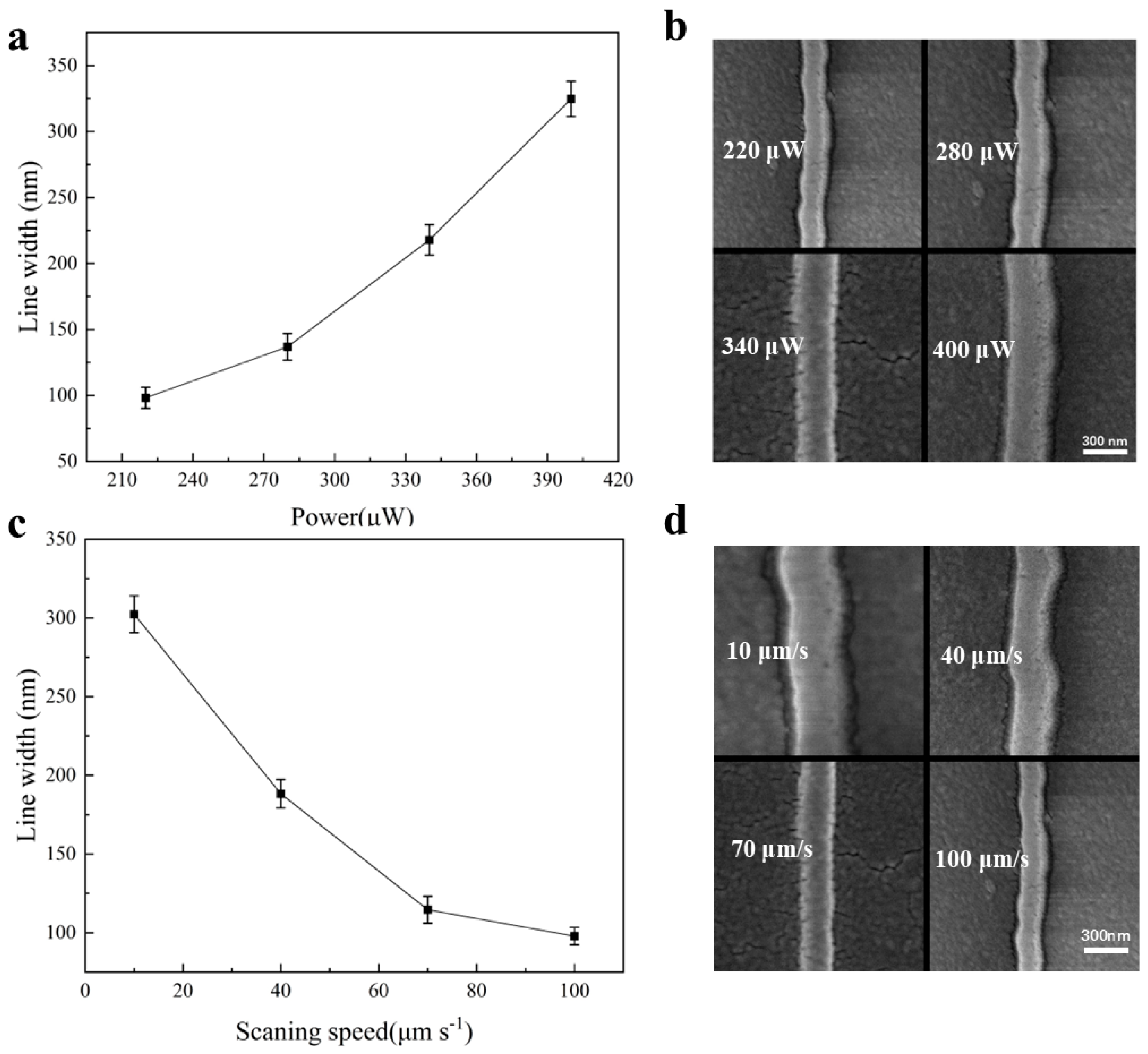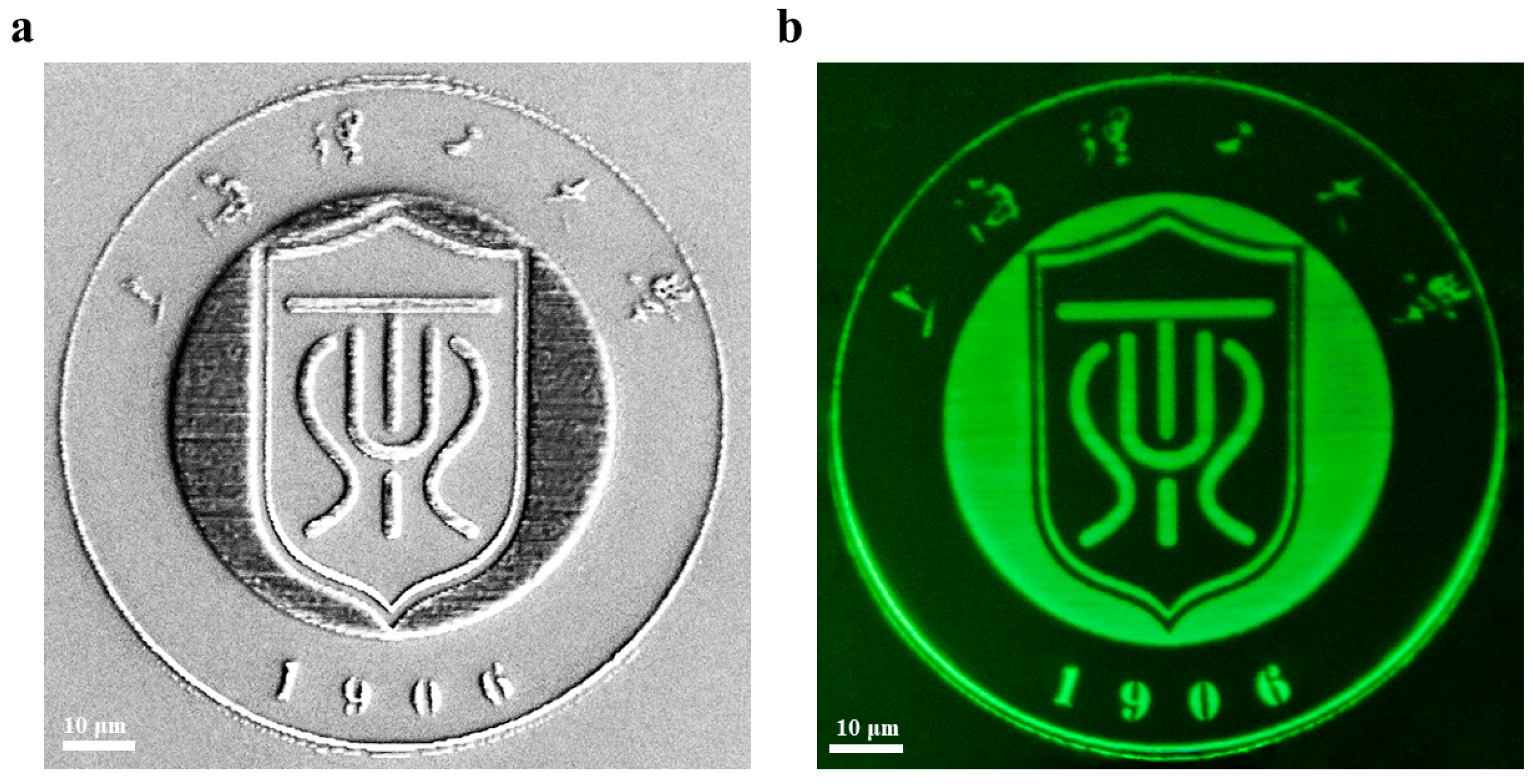Three-Dimensional High-Resolution Laser Lithography of CsPbBr3 Quantum Dots in Photoresist with Sub-100 nm Feature Size
Abstract
:1. Introduction
2. Materials and Methods
3. Results and Discussions
3.1. Optimization of the Minimum Line Width
3.2. Characterization of the CsPbBr3 Quantum Dots
3.3. Fluorescence Display of CsPbBr3 PQD Photoresist Nanocomposite
4. Conclusions
Supplementary Materials
Author Contributions
Funding
Data Availability Statement
Conflicts of Interest
References
- Sheng, Y.; Wen, X.; Jia, B.; Gan, Z. Direct laser writing on halide perovskites: From mechanisms to applications. Light. Adv. Manuf. 2024, 4, 95–116. [Google Scholar] [CrossRef]
- Tan, D.; Sun, K.; Li, Z.; Xu, B.; Qiu, J. Photo-processing of perovskites: Current research status and challenges. Opto-Electronic Sci. 2022, 1, 220014. [Google Scholar] [CrossRef]
- Cao, Z.; Hu, F.; Zhang, C.; Zhu, S.; Xiao, M.; Wang, X. Optical studies of semiconductor perovskite nanocrystals for classical optoelectronic applications and quantum information technologies: A review. Adv. Photonics 2020, 2, 054001. [Google Scholar] [CrossRef]
- Zhang, Y.; Zhu, S.; Hu, J.; Gu, M. Femtosecond laser direct nanolithography of perovskite hydration for temporally programmable holograms. Nat. Commun. 2024, 15, 6661. [Google Scholar] [CrossRef] [PubMed]
- Jeong, S.-J.; Cho, S.; Moon, B.; Teku, J.A.; Jeong, M.-H.; Lee, S.; Kim, Y.; Lee, J.-S. Zero Dimensional–Two Dimensional Hybrid Photodetectors Using Multilayer MoS2 and Lead Halide Perovskite Quantum Dots with a Tunable Bandgap. ACS Appl. Mater. Interfaces 2023, 15, 5432–5438. [Google Scholar] [CrossRef]
- Maes, J.; Balcaen, L.; Drijvers, E.; Zhao, Q.; De Roo, J.; Vantomme, A.; Vanhaecke, F.; Geiregat, P.; Hens, Z. Light Absorption Coefficient of CsPbBr3 Perovskite Nanocrystals. J. Phys. Chem. Lett. 2018, 9, 3093–3097. [Google Scholar] [CrossRef]
- Shi, D.; Adinolfi, V.; Comin, R.; Yuan, M.; Alarousu, E.; Buin, A.; Chen, Y.; Hoogland, S.; Rothenberger, A.; Katsiev, K.; et al. Low trap-state density and long carrier diffusion in organolead trihalide perovskite single crystals. Science 2015, 347, 519–522. [Google Scholar] [CrossRef] [PubMed]
- Pan, J.-A.; Ondry, J.C.; Talapin, D.V. Direct Optical Lithography of CsPbX3 Nanocrystals via Photoinduced Ligand Cleavage with Postpatterning Chemical Modification and Electronic Coupling. Nano Lett. 2021, 21, 7609–7616. [Google Scholar] [CrossRef]
- Mazzotta, A.; Gabbani, A.; Carlotti, M.; Ruggeri, M.; Fantechi, E.; Ottomaniello, A.; Pineider, F.; Pucci, A.; Mattoli, V. Invisible Thermoplasmonic Indium Tin Oxide Nanoparticle Ink for Anti-counterfeiting Applications. ACS Appl. Mater. Interfaces 2022, 14, 35276–35286. [Google Scholar] [CrossRef]
- Yao, Z.; Xiong, Y.; Kang, H.; Xu, X.; Guo, J.; Li, W.; Xu, X. Tunable Periodic Nanopillar Array for MAPbI3 Perovskite Photodetectors with Improved Light Absorption. ACS Omega 2024, 9, 2606–2614. [Google Scholar] [CrossRef]
- Bai, Y.; Hao, M.; Ding, S.; Chen, P.; Wang, L. Surface Chemistry Engineering of Perovskite Quantum Dots: Strategies, Applications, and Perspectives. Adv. Mater. 2021, 34, 2105958. [Google Scholar] [CrossRef]
- Liang, S.; Liu, Y.; Wang, S.; Ji, Z.; Xia, H.; Bai, B.; Sun, H. High-Resolution Patterning of 2D Perovskite Films through Femtosecond Laser Direct Writing. Adv. Funct. Mater. 2022, 32, 0224957. [Google Scholar] [CrossRef]
- Guo, W.; Chen, J.; Ma, T.; Chen, Z.; Li, M.; Zeng, H.; Lu, J. Direct Photolithography Patterning of Quantum Dot-Polymer. Adv. Funct. Mater. 2023, 34, 2310338. [Google Scholar] [CrossRef]
- Gan, Z.; Cao, Y.; Evans, R.A.; Gu, M. Three-dimensional deep sub-diffraction optical beam lithography with 9 nm feature size. Nat. Commun. 2013, 4, 2061. [Google Scholar] [CrossRef]
- Liu, D.; Weng, K.; Lu, S.; Li, F.; Abudukeremu, H.; Zhang, L.; Yang, Y.; Hou, J.; Qiu, H.; Fu, Z.; et al. Direct optical patterning of perovskite nanocrystals with ligand cross-linkers. Sci. Adv. 2022, 8, eabm8433. [Google Scholar] [CrossRef] [PubMed]
- Zhuang, W.; Li, S.; Deng, F.; Li, G.; Tie, S.; Lan, S. Laser writing of CsPbBr3 nanocrystals mediated by closely-packed Au nanoislands. Appl. Surf. Sci. 2021, 538, 148143. [Google Scholar] [CrossRef]
- Sun, K.; Tan, D.; Fang, X.; Xia, X.; Lin, D.; Song, J.; Lin, Y.; Liu, Z.; Gu, M.; Yue, Y.; et al. Three-dimensional direct lithography of stable perovskite nanocrystals in glass. Science 2022, 375, 307–310. [Google Scholar] [CrossRef]
- Huang, X.; Guo, Q.; Yang, D.; Xiao, X.; Liu, X.; Xia, Z.; Fan, F.; Qiu, J.; Dong, G. Reversible 3D laser printing of perovskite quantum dots inside a transparent medium. Nat. Photon- 2019, 14, 82–88. [Google Scholar] [CrossRef]
- Liang, S.-Y.; Liu, Y.-F.; Wang, S.-Y.; Xia, H.; Sun, H.-B. High-resolution in situ patterning of perovskite quantum dots via femtosecond laser direct writing. Nanoscale 2021, 14, 1174–1178. [Google Scholar] [CrossRef]
- Cao, Z.; Lv, B.; Zhang, H.; Lv, Y.; Zhang, C.; Zhou, Y.; Wang, X.; Xiao, M. Two-photon excited photoluminescence of single perovskite nanocrystals. J. Chem. Phys. 2019, 151, 154201. [Google Scholar] [CrossRef]
- Lipovka, A.; Garcia, A.; Abyzova, E.; Fatkullin, M.; Song, Z.; Li, Y.; Wang, R.; Rodriguez, R.D.; Sheremet, E. Laser Processing of Emerging Nanomaterials for Optoelectronics and Photocatalysis. Adv. Opt. Mater. 2024, 12, 2303194. [Google Scholar] [CrossRef]
- Cao, Y.; Gan, Z.; Jia, B.; Evans, R.A.; Gu, M. High-photosensitive resin for super-resolution direct-laser-writing based on photoinhibited polymerization. Opt. Express 2011, 19, 19486–19494. [Google Scholar] [CrossRef]
- Hu, J.; Guo, R.; Zhu, S.; Yang, R.; Gu, M.; Zhang, Y. Full-Color and High-Resolution Femtosecond Laser Patterning of Perovskite Quantum Dots in Polyacrylonitrile Matrix. Adv. Funct. Mater. 2024, 34, 2407116. [Google Scholar] [CrossRef]
- Sun, K.; Tan, D.; Song, J.; Xiang, W.; Xu, B.; Qiu, J. Highly Emissive Deep-Red Perovskite Quantum Dots in Glass: Photoinduced Thermal Engineering and Applications. Adv. Opt. Mater. 2021, 9, 2100094. [Google Scholar] [CrossRef]
- Cao, C.; Qiu, Y.; Guan, L.; Wei, Z.; Yang, Z.; Zhan, L.; Zhu, D.; Ding, C.; Shen, X.; Xia, X.; et al. Dip-In Photoresist for Photoinhibited Two-Photon Lithography to Realize High-Precision Direct Laser Writing on Wafer. ACS Appl. Mater. Interfaces 2022, 14, 31332–31342. [Google Scholar] [CrossRef] [PubMed]
- Chang, S.; Bai, Z.; Zhong, H. In Situ Fabricated Perovskite Nanocrystals: A Revolution in Optical Materials. Adv. Opt. Mater. 2018, 6, 1800380. [Google Scholar] [CrossRef]
- Liang, S.-Y.; Liu, Y.-F.; Zhang, H.-J.; Ji, Z.-K.; Xia, H. High-Quality Patterning of CsPbBr3 Perovskite Films through Lamination-Assisted Femtosecond Laser Ablation toward Light-Emitting Diodes. ACS Appl. Mater. Interfaces 2022, 14, 46958–46963. [Google Scholar] [CrossRef] [PubMed]
- Chen, J.; Wu, Y.; Li, X.; Cao, F.; Gu, Y.; Liu, K.; Liu, X.; Dong, Y.; Ji, J.; Zeng, H. Simple and Fast Patterning Process by Laser Direct Writing for Perovskite Quantum Dots. Adv. Mater. Technol. 2017, 2, 1700132. [Google Scholar] [CrossRef]
- Haske, W.; Chen, V.W.; Hales, J.M.; Dong, W.; Barlow, S.; Marder, S.R.; Perry, J.W. 65 nm feature sizes using visible wavelength 3-D multiphoton lithography. Opt. Express 2007, 15, 3426–3436. [Google Scholar] [CrossRef]
- Zhan, W.; Meng, L.; Shao, C.; Wu, X.-G.; Shi, K.; Zhong, H. In Situ Patterning Perovskite Quantum Dots by Direct Laser Writing Fabrication. ACS Photonics 2021, 8, 765–770. [Google Scholar] [CrossRef]
- Nie, L.; Wang, T.; Yu, X.; Gao, W.; Peng, Q.; Xia, Z.; Qiu, J.; Yu, S.F.; Xu, X. Multicolor Display Fabricated via Stacking CW Laser-Patterned Perovskite Films. ACS Energy Lett. 2023, 8, 2025–2032. [Google Scholar] [CrossRef]
- Liu, Y.; Li, Y.; Hu, X.; Wei, C.; Xu, B.; Leng, J.; Miao, H.; Zeng, H.; Li, X. Ligands for CsPbBr3 perovskite quantum dots: The stronger the better? Chem. Eng. J. 2022, 453, 139904. [Google Scholar] [CrossRef]
- Motti, S.G.; Krieg, F.; Ramadan, A.J.; Patel, J.B.; Snaith, H.J.; Kovalenko, M.V.; Johnston, M.B.; Herz, L.M. CsPbBr3 Nanocrystal Films: Deviations from Bulk Vibrational and Optoelectronic Properties. Adv. Funct. Mater. 2020, 30, 1909904. [Google Scholar] [CrossRef]
- Sheng, Y.; Liu, C.; Yu, L.; Yang, Y.; Hu, F.; Sheng, C.; Di, Y.; Dong, L.; Gan, Z. Microsteganography on all inorganic perovskite micro-platelets by direct laser writing. Nanoscale 2021, 13, 14450–14459. [Google Scholar] [CrossRef] [PubMed]
- Kim, S.-Y.; Kim, K.; Hwang, Y.H.; Jang, J.; Nam, Y.; Kang, Y.; Kim, M.; Park, H.J.; Lee, Z.; Choi, J.; et al. High-resolution electrohydrodynamic inkjet printing of stretchable metal oxide semiconductor transistors with high performance. Nanoscale 2016, 8, 17113–17121. [Google Scholar] [CrossRef]
- Khan, A.; Rahman, K.; Ali, S.; Khan, S.; Wang, B.; Bermak, A. Fabrication of circuits by multi-nozzle electrohydrodynamic inkjet printing for soft wearable electronics. J. Mater. Res. 2021, 36, 3568–3578. [Google Scholar] [CrossRef]




Disclaimer/Publisher’s Note: The statements, opinions and data contained in all publications are solely those of the individual author(s) and contributor(s) and not of MDPI and/or the editor(s). MDPI and/or the editor(s) disclaim responsibility for any injury to people or property resulting from any ideas, methods, instructions or products referred to in the content. |
© 2025 by the authors. Licensee MDPI, Basel, Switzerland. This article is an open access article distributed under the terms and conditions of the Creative Commons Attribution (CC BY) license (https://creativecommons.org/licenses/by/4.0/).
Share and Cite
Cai, B.; Jiang, H.; Bai, R.; Zhu, S.; Zhang, Y.; Yu, H.; Gu, M.; Zhang, Q. Three-Dimensional High-Resolution Laser Lithography of CsPbBr3 Quantum Dots in Photoresist with Sub-100 nm Feature Size. Nanomaterials 2025, 15, 531. https://doi.org/10.3390/nano15070531
Cai B, Jiang H, Bai R, Zhu S, Zhang Y, Yu H, Gu M, Zhang Q. Three-Dimensional High-Resolution Laser Lithography of CsPbBr3 Quantum Dots in Photoresist with Sub-100 nm Feature Size. Nanomaterials. 2025; 15(7):531. https://doi.org/10.3390/nano15070531
Chicago/Turabian StyleCai, Boyuan, Haoran Jiang, Run Bai, Shengting Zhu, Yinan Zhang, Haoyi Yu, Min Gu, and Qiming Zhang. 2025. "Three-Dimensional High-Resolution Laser Lithography of CsPbBr3 Quantum Dots in Photoresist with Sub-100 nm Feature Size" Nanomaterials 15, no. 7: 531. https://doi.org/10.3390/nano15070531
APA StyleCai, B., Jiang, H., Bai, R., Zhu, S., Zhang, Y., Yu, H., Gu, M., & Zhang, Q. (2025). Three-Dimensional High-Resolution Laser Lithography of CsPbBr3 Quantum Dots in Photoresist with Sub-100 nm Feature Size. Nanomaterials, 15(7), 531. https://doi.org/10.3390/nano15070531





